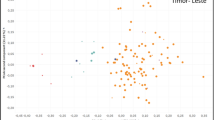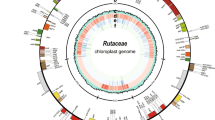Abstract
Natural hybridization has played a significant role in the evolution of the genus Rosa. Kushui Rose (R. sertata × R. rugosa) is a natural hybrid of R. sertata and the cultivated rose R. rugosa. We conducted molecular sequence analysis and a morphological traits examination in the related taxa of the genus to test the hybrid origin of Kushui Rose. Although principal component analysis of the morphological characteristics revealed that Kushui Rose was intermediate between R. rugosa and R. willmottiae, and R. sertata, the unambiguous sequence additivities of the nuclear DNAs (ITS and GAPDH), as well as the incongruence between the nuclear and chloroplast gene trees, revealed that the hybrid origin of Kushui Rose was R. rugosa and R. willmottiae rather than R. sertata. Furthermore, the cluster relationships in the concatenated chloroplast (cpDNA) trees (psbA-trnH, trnL-F, and trnS-G) implied that R. willmottiae and R. rugosa acted as the maternal parent and the paternal parent, respectively, during homoploidization speciation. Here, our research provides a more reasonable orientation for further tracing the origin of this hybrid species and research on its horticultural traits with heterosis.






Similar content being viewed by others
Data availability
The datasets generated during the current study are available in the GenBank repository.
References
Atienza SG, Torres AM, Millan T et al (2005) Genetic diversity in Rosa as revealed by RAPDs. Agric Conspec Sci 70:75
Bai J, Zhang Q, Pan H et al (2009) Recent advances in molecular biotechnology of the genus Rosa L. J Northwest For Univ 24(06):43–49
Boratyn GM, Christiam C, Cooper PS et al (2013) BLAST: a more efficient report with usability improvements. Nucleic Acids Res W1:W29–W33
Cabria MT, Michaux JR, Gómez-Moliner BJ et al (2011) Bayesian analysis of hybridization and introgression between the endangered european mink (Mustela lutreola) and the polecat (Mustela putorius). Mol Ecol 20(6):1176–1190
Carney SE, Gardner KA, Rieseberg LH (2000) Evolutionary changes over the fifty-year history of a hybrid population of sunflowers (Helianthus). Evolution 54(2):462–474
Cheng J, Wang B, Liu Q, Zhou W (2019) Extraction total flavonoids and determination of main compounds in Kushui Rose. J Food Sci Biotechnol 38(05):153–159
Costea M, Stefanović S (2010) Evolutionary history and taxonomy of the Cuscuta umbellata complex (Convolvulaceae): Evidence of extensive hybridization from discordant nuclear and plastid phylogenies. Taxon 59:1783–1800
Cui W, Du X, Zhong M et al (2022) Complex and reticulate origin of edible roses (Rosa, Rosaceae) in China. Hortic Res. https://doi.org/10.1093/hr/uhab051
Doyle JJ, Doyle JL (1987) A rapid DNA isolation procedure for small quantities of fresh leaf tissue[J]. Phytochemical bulletin 19:11–15.
Fang Q, Tian M, Zhang T et al (2020) Karyotype analysis of Rosa praelucens and its closely related congeneric species based on FISH. Acta Hortic Sinica 47(03):503–516
Flora of China Editorial Committee of Chinese Academy of Sciences (1985) Flora of China (37Volume). Science Press, Beijing
Gross B (2012) Genetic and phenotypic divergence of homoploid hybrid species from parental species. Heredity 108:157–158
Gruenstaeudl M, Santos-Guerra A, Jansen RK (2012) Phylogenetic analyses of Tolpis Adans. (Asteraceae) reveal patterns of adaptive radiation, multiple colonization and interspecific hybridization. Cladistics 29:416–434
Guo P et al (2017) The present situation of exploitation and utilization and development countermeasures of Rose Sertata × R. rugosa Yu. et. ku. Anhui Agric Sci Bulletin 13:31–38
Hegarty MJ, Hiscock SJ (2005) Hybrid speciation in plants: new insights from molecular studies. New Phytol 165(2):411–423
Horie S, Suzuki K, Maki M (2012) Quantitative morphological analysis of populations in a hybrid zone of Epimedium diphyllum and E. sempervirens var. rugosum (Berberidaceae). Plant Ecol Evolut 145(1):88–95
Jin J (2000) The comprehensive development of rose. Chin Wild Plant Resour 19:21–23
Joseph LC, Annette WC (1988) Rapid screening method to detect potential biparental inheritance of plastid DNA and results for over 200 angiosperm species. Am J Bot 75(10):1443–1458
Kumar S, Stecher G, Tamura K (2016) MEGA7: Molecular evolutionary genetics analysis version 7.0 for bigger datasets. Molecular Biol Evolut 33(7):1870–4
Librado P, Rozas J (2009) DnaSP v5: A software for comprehensive analysis of DNA polymorphism data. Bioinformatics 25:1451–1452
Liu Y, Zhi D, Wang X et al (2018) Kushui Rose (R. Setate x R. Rugosa) decoction exerts antitumor effects in C. elegans by downregulating Ras/MAPK pathway and resisting oxidative stress. Int J Mol Med 42(3):1411–1417
Ma Z, Chang Y, Hou S (1985) Biological characteristics of Kushui Rose and cultivation techniques. Gansu Agric Sci Technol 08:18–20
Ma Z, Chang Y, Hou S (1990) Studies on flowering biology of Kushui Rose. J Gansu Sci 02:32–36
Niu Y, Xu Q, Zhang J, Wang Y (2017) Analysis on morphology and aromatic composition of four varieties of Rosa rugosa ‘kushui.’ Nonwood For Res 35(4):248–253
Niu Y, Xu Q, Wang Y et al (2015) Morphological observation and aroma composition analysis of natural variation types of Chinese Kushui Rose. In: 2015 Annual Conference of Chinese Society for Horticultural Science, Xiamen
Rieseberg LH (1997) Hybrid origins of plant species. Annu Rev Ecol Syst 28(1):359–389
Rieseberg LH, Carter R, Zona S (1990) Molecular tests of the hypothesized hybrid origin of two diploid Helianthus species (Asteraceae). Evolution 44(6):1498–1511
Rieseberg LH, Ellstrand NC et al (1993) What can molecular and morphological markers tell us about plant Hybridization? Crit Rev Plant Sci 12(3):213
Rieseberg LH, Baird S, Gardner KA (2000) Hybridization, introgression, and linkage evolution. Plant Mol Biol 42(1):205–224
Soltis PS, Doyle JJ, Soltis DE (1992) Molecular data and polyploid evolution in plants. Springer US Chapter 8: 177-201
Sun K, Ma R, Chen X et al (2003) Hybrid origin of the diploid species Hippophae goniocarpa evidenced by the internal transcribed spacers (ITS) of nuclear rDNA. Belg J Bot 136(1):91–96
Wang Y (2017) Natural hybridization and speciation. Biodivers Sci 25(06):565–576
Wang H (2018) The aromatic resources of genus Rosa and their development and utilization in China. Flavour Fragr Cosmet 6:63–67
Wang H, Yao L (2012) Domestic-overseas current situation and research progress of oil-bearing rose. Flavour Fragr Cosmet 02:47–51
Wang H, Yao L, Cai R et al (2012) Genetic relationship analyses of oil-bearing roses in China using matK sequences. Sci Hortic 137:121–124
Wang Y, Zhang Y, Jiao Z et al (2022) Preliminary sudy on cross fertility in ‘Kushui’ Rose. Bulletin Bot Res 42(3):403–411
Yang C, Ma Y, Cheng B et al (2020) Molecular evidence for hybrid origin and phenotypic variation of Rosa section Chinenses. Genes 11(9):996
Zhang W, Wu Y, Gao Y (2018) Study on rapid propagation technique system of Kushui Rose. Gansu Agric Sci Technol 09:4–7
Zhang C, Li S, Zhang Y et al (2020) Molecular and morphological evidence for hybrid origin and matroclinal inheritance of an endangered wild rose, Rosa × pseudobanksiae (Rosaceae) from China. Conserv Genet 21(1):1–11
Zhang H (2005) Homoploid hybrid origin of Hippophae goniocarpa subsp. goniocarpa Evidence from chloroplast genome and nuclear genome. Dissertation, Northwest Normal University
Zhao X, Zhao L, Zhang N et al (2007) Karyotype analysis of Rosa rugosa ‘plena’ and Rosa rugosa ‘Kushui.’ Shandong For Sci Technol 5:46–47
Funding
This work was supported by National Natural Science Foundation of China (31060033). Industry Support Plan Project of Gansu Province Higher Education (2022CYZC-14). Open Fund Project of the State Key Laboratory of Chromosome Engineering, Institute of Genetic Development, Chinese Academy of Sciences (PCCE-KF-2019-06). Science and Technology Program of Gansu Province (22JR5RA169).
Author information
Authors and Affiliations
Contributions
All authors contributed to the study conception and design. Material preparation, data collection and analysis were performed by YW, FZ, LLD and HZ. The first draft of the manuscript was written by FZ and all authors commented on previous versions of the manuscript. All authors read and approved the final manuscript.
Corresponding authors
Ethics declarations
Conflict of interest
The authors have no relevant financial or non-financial interests to disclose.
Additional information
Publisher's Note
Springer Nature remains neutral with regard to jurisdictional claims in published maps and institutional affiliations.
Rights and permissions
Springer Nature or its licensor (e.g. a society or other partner) holds exclusive rights to this article under a publishing agreement with the author(s) or other rightsholder(s); author self-archiving of the accepted manuscript version of this article is solely governed by the terms of such publishing agreement and applicable law.
About this article
Cite this article
Zhao, F., Wang, Y., Zhang, Yj. et al. Molecular and morphological evidences for the hybrid origin of Kushui Rose. Genet Resour Crop Evol 71, 1257–1269 (2024). https://doi.org/10.1007/s10722-023-01688-4
Received:
Accepted:
Published:
Issue Date:
DOI: https://doi.org/10.1007/s10722-023-01688-4




